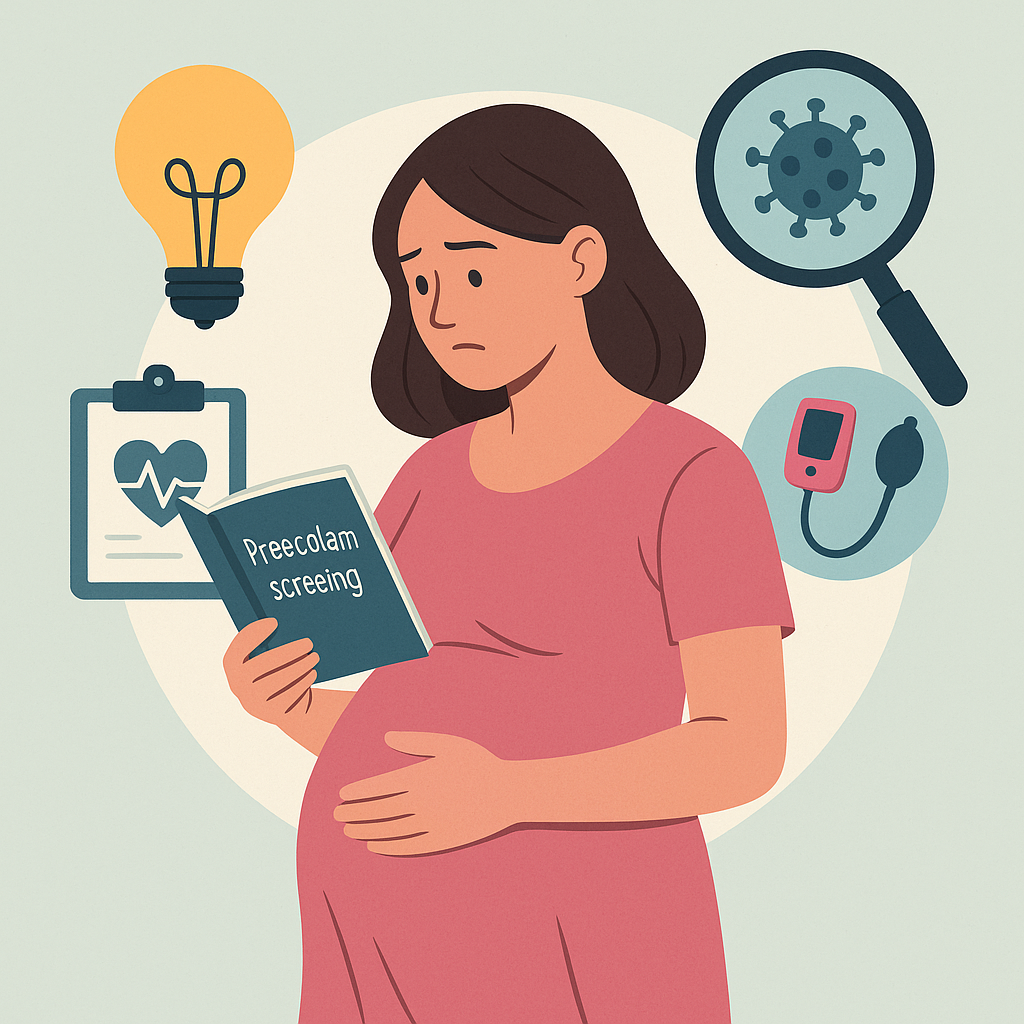FACTORS AFFECTING PREGNANT WOMEN'S KNOWLEDGE LEVEL OF PREECLAMPSIA SCREENING

Downloads
Background: Preeclampsia is a hypertensive syndrome affecting 3–8% of pregnancies worldwide, involving multiple organ systems, and typically occurring after 20 weeks of gestation. In Surabaya, 1,265 cases were reported in 2023. Optimal prevention of preeclampsia is achieved through early screening at 11–13 weeks of gestation during antenatal care. Maternal knowledge and awareness are essential determinants of timely screening, as non-adherence to antenatal care has been associated with insufficient understanding of pregnancy management, delayed recognition of complications including preeclampsia and chronic conditions, and has ultimately contributed to the persistently high rates of preeclampsia and maternal and neonatal mortality in Indonesia. The aim was to analyze factors influencing pregnant women’s knowledge regarding preeclampsia screening. Method: This research employed a quantitative design with a cross-sectional approach, using a purposive sampling method. This study involved 91 pregnant women who met the inclusion criteria: women in the first to third trimester of pregnancy who had attended at least two antenatal care visits. A structured questionnaire was used as the research instrument. Data were analyzed using the Spearman rank correlation test to examine the relationship between educational level and parity experience and the pregnant women’s level of knowledge regarding preeclampsia screening. Results: The study included 91 pregnant women as respondents. 56 % respondent had secondary level of education, 52% respondents were moderate parity and 52 % respondents demonstrated good knowledge, Showed significant associations between education level (p < 0.001) and parity (p = 0.031) with knowledge of preeclampsia screening. Conclusions: That demographic factors and reproductive experiences influence maternal knowledge. Therefore, education on preeclampsia screening should be tailored to maternal characteristics, and the active involvement of healthcare providers is essential to support comprehensive, holistic, and sustainable midwifery care.
Dahniar Dahniar, Ibrahim, R. and Yusuf, S.A. (2023). Hubungan Paritas Dengan Pengetahuan Ibu Hamil Tentang Tanda Bahaya Kehamilan di UPTD Puskesmas Lambandia. Journal Pelita Sains Kesehatan, 3(4), pp.54–60.
Dinkes Provinsi Jatim. (2024). Profil Kesehatan Jawa Timur 2023: 87-92
Harahap, Htd (2020). Pengaruh Kemampuan Ibu Hamil Dalam Melakukan Deteksi Dini Risiko Preeklamsia Terhadap Paritas, Pengetahuan dan Keterpaparan Informasi. Jurnal Wahana Inovasi, 9(2), 33-38
Heryanti And Sintia, C. (2022). The Relationship of Parity and Education With Pregnant Women’s Knowledge About Pregnancy Hazard Sign at Tulung Puskesmas Selapan 2020. Jurnal Kesehatan dan Pembangunan, 12(24), pp.30–39. doi: https://doi.org/10.52047/jkp.v12i24.165.
Kemkes.Go.Id. (2024). Profil Kesehatan Indonesia 2023: 105-111
Kusumastuti, Istiana. (2018). Hubungan Karakteristik Ibu, Paritas dan Sumber Informasi Dengan Pengetahuan Ibu Tentang Tanda Bahaya Kehamilan (di Puskesmas Kecamatan Karang Tengah Kabupaten Cianjur). Artikel Penelitian. 8 (3):124-132
Lestari, Y., Jahro, S., & Wulandari, D. (2023). Status Gravida, Tingkat Pengetahuan, Usia, dan Kepatuhan ANC Terhadap Kemampuan Ibu Hamil Melakukan Deteksi Dini Resiko Preeklampsia di Puskesmas Sumberasih. Jurnal Riset Kebidanan Indonesia, 6(2), 104-111. doi: https://doi.org/10.32536/jrki.v6i2.226
Mekie, M., Addisu, D., Bezie, M., Melkie, A., Getaneh, D., Bayih, W.A. And Taklual, W. (2021). Knowledge and Attitude of Pregnant Women Towards Preeclampsia and its Associated Factors in South Gondar Zone, Northwest Ethiopia: A Multi‐Center Facility‐Based Cross‐Sectional Study. BMC Pregnancy and Childbirth, 21(1). doi:https://doi.org/10.1186/s12884-021-03647-2.
Osungbade., Ige. (2011). Public Health Perspectives Of Preeclampsia In Developing Countries: Implication For Health System Strengthening. The Hindawi Journal Of Pregnancy: 1-6
Rahayu, D., & Yunarsih. (2020). Predisposing Factors Of The Pre Exlampsia. 10(1), 19–26.
Shodiqoh, E. R., & Fahriani, S. (2018). Perbedaan Tingkat Kecemasan dalam Menghadapi Persalina antara Primigravida dan Multigravida. Jurnal Berkala Epidemologi Surabaya. Universitas Airlangga Jawa Timur, 141–150
Wulandari, D., Alkaf, S., & Zulissetiana, E. F. (2020). Tingkat Pengetahuan Ibu Hamil Tentang Preeklampsia di Klinik Al-Syifa Kota Palembang. Disertasi. Universitas Sriwijaya
Yasinta Eka, Aprilia (2023). Hubungan Pengetahuan Dan Kepatuhan Antenatal Care (Anc) Dengan Kejadian Preeklamsia Pada Ibu Hamil (Studi Di Poli Kandungan Rsud Syarifah Ambami Rato Ebu) - Repositori Stikes Ngudia Husada Madura
Copyright (c) 2025 Salwa Fatharani, Andriyanti, Ernawati, Atika

This work is licensed under a Creative Commons Attribution-ShareAlike 4.0 International License.
1. The journal allows the author to hold the copyright of the article without restrictions.
2. The journal allows the author(s) to retain publishing rights without restrictions
3. The formal legal aspect of journal publication accessibility refers to Creative Commons Atribution-Share Alike 4.0 (CC BY-SA).
This Journal (e-ISSN 2656-7806) is licensed under a Creative Commons Attribution-ShareAlike 4.0 International License.
















